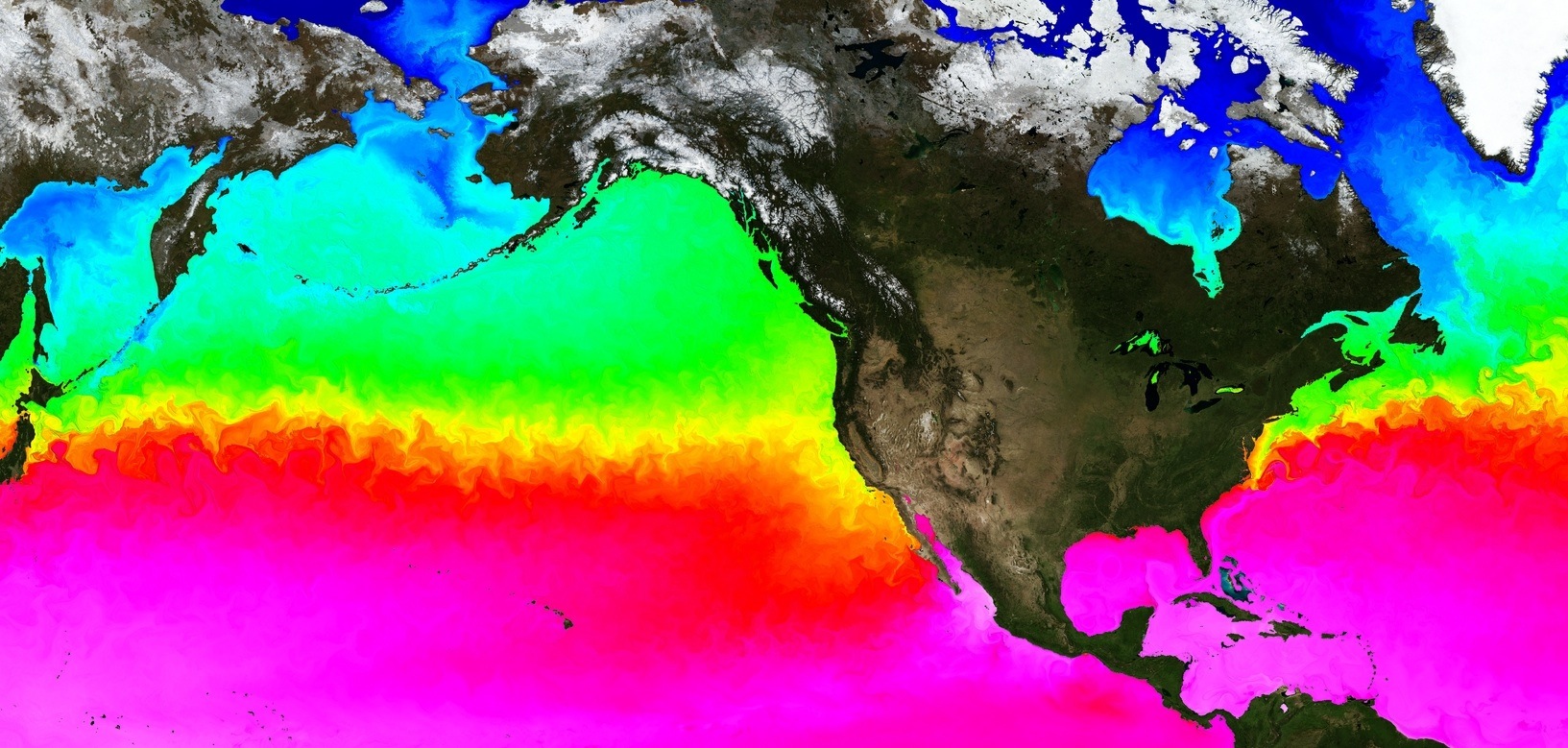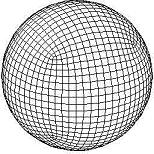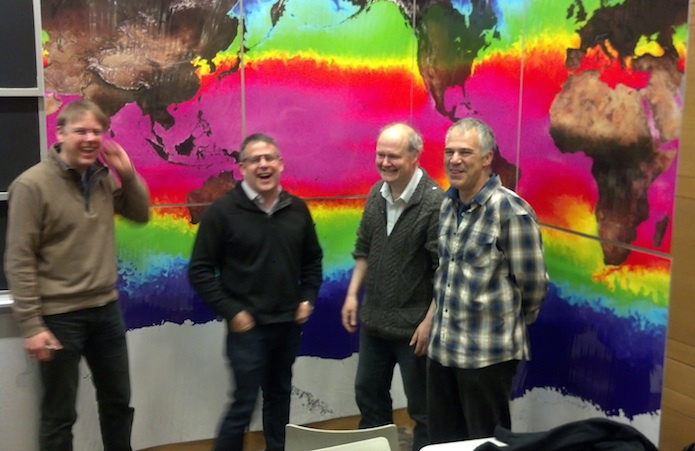PAOC Spotlights
A Brave New Ocean World
After 20 years of work, the new high-resolution virtual ocean, the MITgcm, is advancing science from theoretical fluid dynamics to marine ecology.
“A picture’s worth a thousand words” is the first thing Chris Hill, Principal Research Engineer at MIT, says to describe the ceiling-to-floor map of the world ocean and continents that covers the walls outside his office in MIT’s Department of Earth, Atmospheric, and Planetary Sciences (EAPS). In fact, this colorful visual explains far more than one thousand words can communicate. It is a detailed representation of ocean behavior from the output of the highest-ever resolution run of a global ocean model.
This map comes from a milestone application of the MIT General Circulation Model (MITgcm), one of the most widely used ocean models in the world, developed here at MIT. The model is a sophisticated computer program that creates a virtual 3-D global ocean complete with sea ice and land. To understand how this works, imagine a program that stretches a fine-mesh grid over the entire globe, dividing it into boxes. At each grid point, a calculator is continually solving sets of equations based on physical laws governing Earth’s fluid motion. Into these equations, researchers input measurements from real world observations of temperature, salinity, and velocity. The smaller the boxes, the higher the model’s resolution and the better it will be at capturing small-scale fluid features. This MITgcm is called high-resolution because it zooms down to one-kilometer boxes and performs its math on billions of grid points.
Processing high-resolution models, however, requires massive computing power. This version of the MITgcm is currently running it’s virtual world on 5,000 computers--that's 50,000 central processing units (CPUs)--in the NASA Advanced Supercomputing facility at Ames Research Center in California’s Silicon Valley.
Hill recently printed out this vibrant image of the model ocean’s surface field to show people what he and his colleagues have been working towards for 20 years. “It’s difficult to just look at a computer screen and see all the large and small-scale patterns represented by the model,” says Hill. “This gives the visual impact.” Indeed, the curling filaments visible on the map show just how well the model can resolve the small-scale narrow currents, such as eddies, that transport heat, carbon, and biological properties within global circulation systems.
Seeing is Believing
This modeling endeavor was unveiled at MIT in a January 22-24 meeting of the Estimating the Circulation and Climate of the Ocean (ECCO) consortium, a joint venture led by MIT, NASA's Jet Propulsion Laboratory, and Scripps Oceanographic Institution that combines observations and the MITgcm to obtain a more realistic understanding of ocean circulation, how it evolves over time, and its impact on global climate. Patrick Heimbach, Senior Research Scientist at MIT, is the Principle Investigator for MIT's ECCO project, which funds the MITgcm high resolution modeling.
This MITgcm is a big deal in the ECCO ocean modelling world because researchers can finally see what a virtual ocean looks like at higher resolutions. They now have a new tool to evaluate the accuracy of their modeling practices and assumptions. For example, while lower resolution models that run at tens or even hundreds of kilometers cannot resolve eddies, they do account for the influence of eddies with classic equations. Zooming in closer will reveal whether these well-worn equations actually capture the eddy dynamics in the way that people think they do.
“We just have to channel Osborne Reynolds!," Hill remarked in his discussion about the potential of the model, getting a laugh from the ECCO audience. He was referencing the Victorian-era fluid dynamicist who set up lab experiments in which he would send a jet of fluid into another fluid to study the swirly instability patterns that result. Reynolds wanted to mathematically represent these small-scale structures in the equations that describe bulk fluid flow. Fast forward to 2014, and ECCO modelers are asking similar questions about the entire ocean, using virtual worlds instead of lab experiments to look at how their understanding of the tiny fluxes of temperature and momentum from small scale circulations relates to what they see on the large scale.
A myriad of other scientific projects around the world rely on the MITgcm open-source code, which MIT research scientist Jean-Michel Campin maintains and improves on a constant basis. Perhaps no other group brings the MITgcm as close to real world phenomena as the MIT Darwin Project, an interdisciplinary collaboration led by Mick Follows, Associate Professor in EAPS. For this group, the higher resolution version of the MITgcm is a game-changer.
Sharpening the Focus on Nature
The MIT Darwin Project investigates the enormous role of phytoplankton in the marine ecosystem. These tiny green cells float around by the billion, together providing half the world’s total oxygen and cycling carbon in our atmosphere and oceans. To investigate these biogeochemical interactions, the Darwin group uses ocean circulation output from lower resolution versions of the MITgcm in their own ecosystems models. Recently, EAPS research scientist Stephanie Dutkiewicz showed that diverse populations of plankton, the base of the ocean food chain, will significantly shift in warmer future oceans.
The thing is, that knowledge is incomplete. Real phytoplankton have complex physiological ways to adapt to new environments, and current models do not resolve the small-scale fluid dynamical environments that constrain phytoplankton biology. But a high-resolution model may be able to rise above that limitation, and Darwin Project member David Talmy, a post doc in EAPS, plans to find out.
Talmy takes advantage of the MITgcm’s sharper focus on the small scale. Based on measurements from ocean cruises and laboratory experiments, he has designed some special mathematical abstractions of phytoplankton—code for virtual plankton cells that more closely reflects how a real cells responds to light, temperature, and nutrient levels in ocean eddies. Working with Mick Follows and Chris Hill, Talmy will soon unleash those virtual organisms in the high-resolution MITgcm and study survival and adaptation patterns in closer detail. "I think we will start to get a feel for how these submesoscale processes influence how a phytoplankton cell experiences and adapts to its environment," he says. Ultimately, this kind of work may help the Darwin Project to understand, for example, how plankton’s ability to cycle carbon may change in warmer oceans.
The opportunity to work with the MITgcm is a large part of what drew Talmy to his research position in the MIT Darwin Project last year. In his view, the MITgcm code can more faithfully represent how a real phytoplankton cell experiences its environment. "Individual organisms experience and track their immediate surroundings, which affect how they respond to the next environment they enter,” he says. “Where they have been matters as much as where they are going." In contrast to past models used to study ecosystems, the MITgcm allows a "Lagrangian" approach to fluid dynamics, which essentially allows a virtual phytoplankton cell to "remember" the light, temperature, and nutrient levels of its past location, as a cell does in the real ocean.
“There are a whole host of future directions that we can travel if we can think about the physiology of specific organisms in greater detail and broaden our models to include other types of organisms,” said Mick Follows at the end of the ECCO conference. "I think the model output will give us new ideas about how we might go out and nail down some of these physiological mechanisms in the ocean." A fitting closing statement indeed, for it captures a point about global ocean modeling that often gets lost in translation outside of science. It's not a mirror of the real world, not a machine of future predictions, but rather a tool to help guide a scientist's interpretation of otherwise confusing phenomena.


